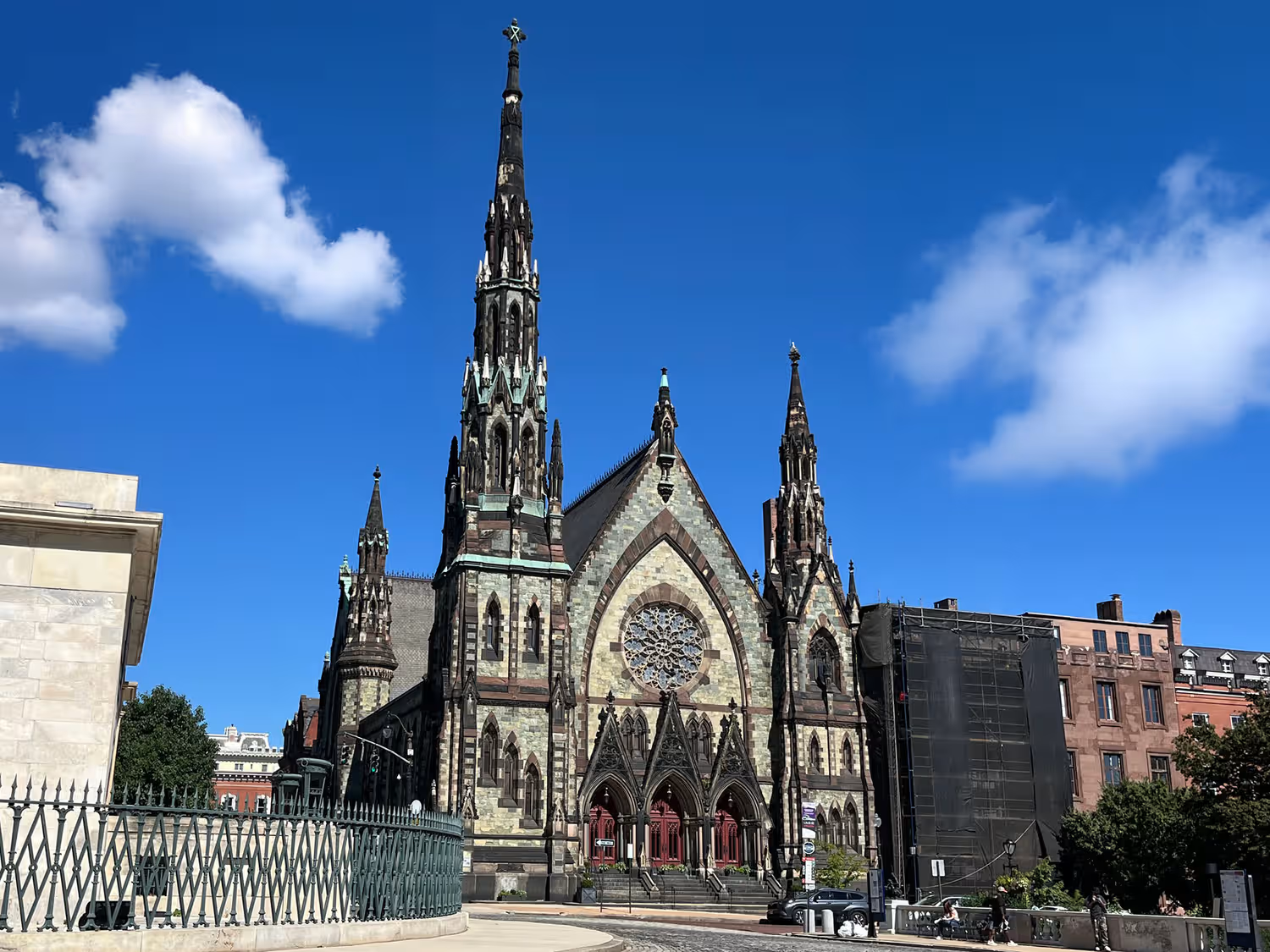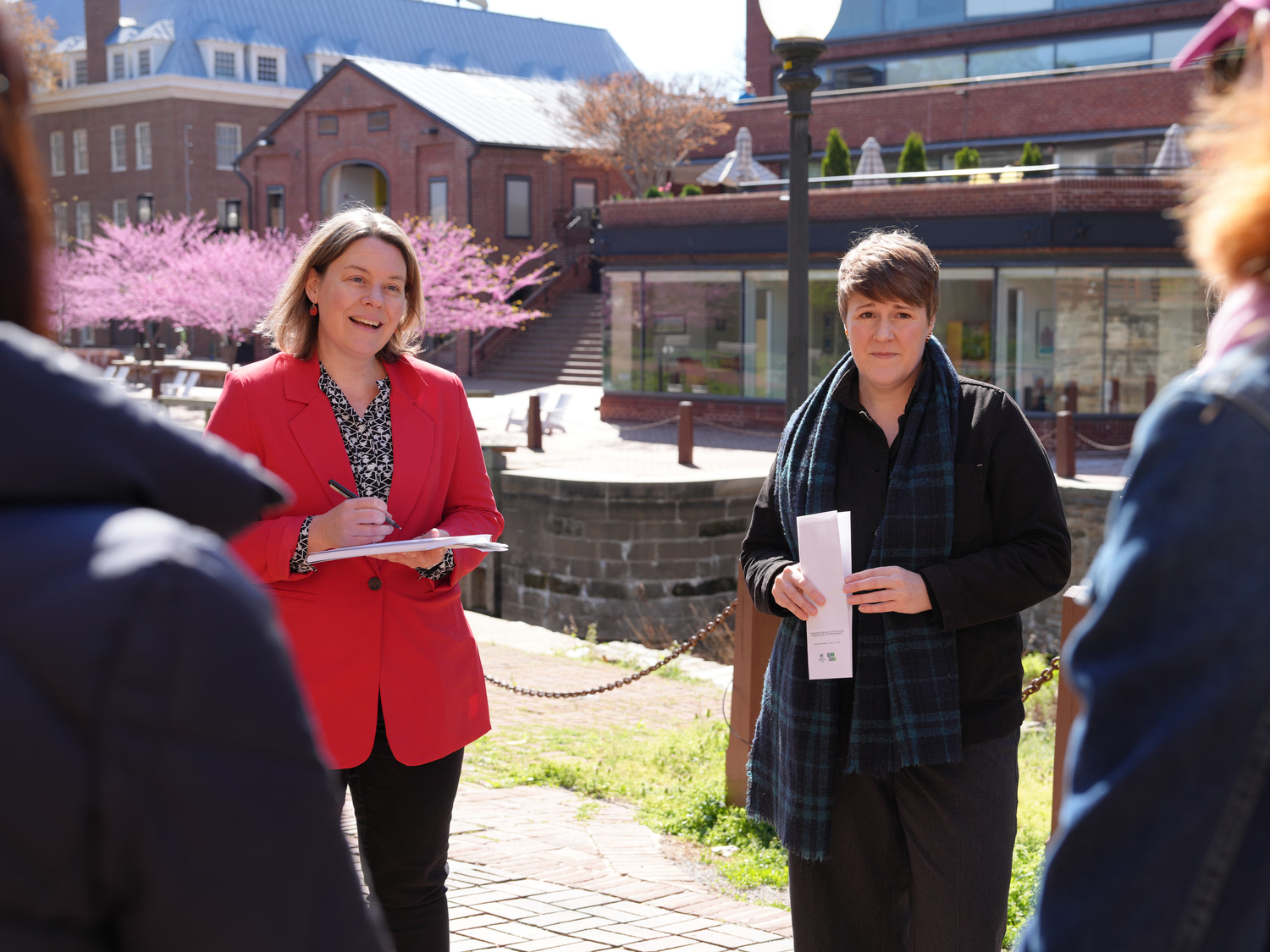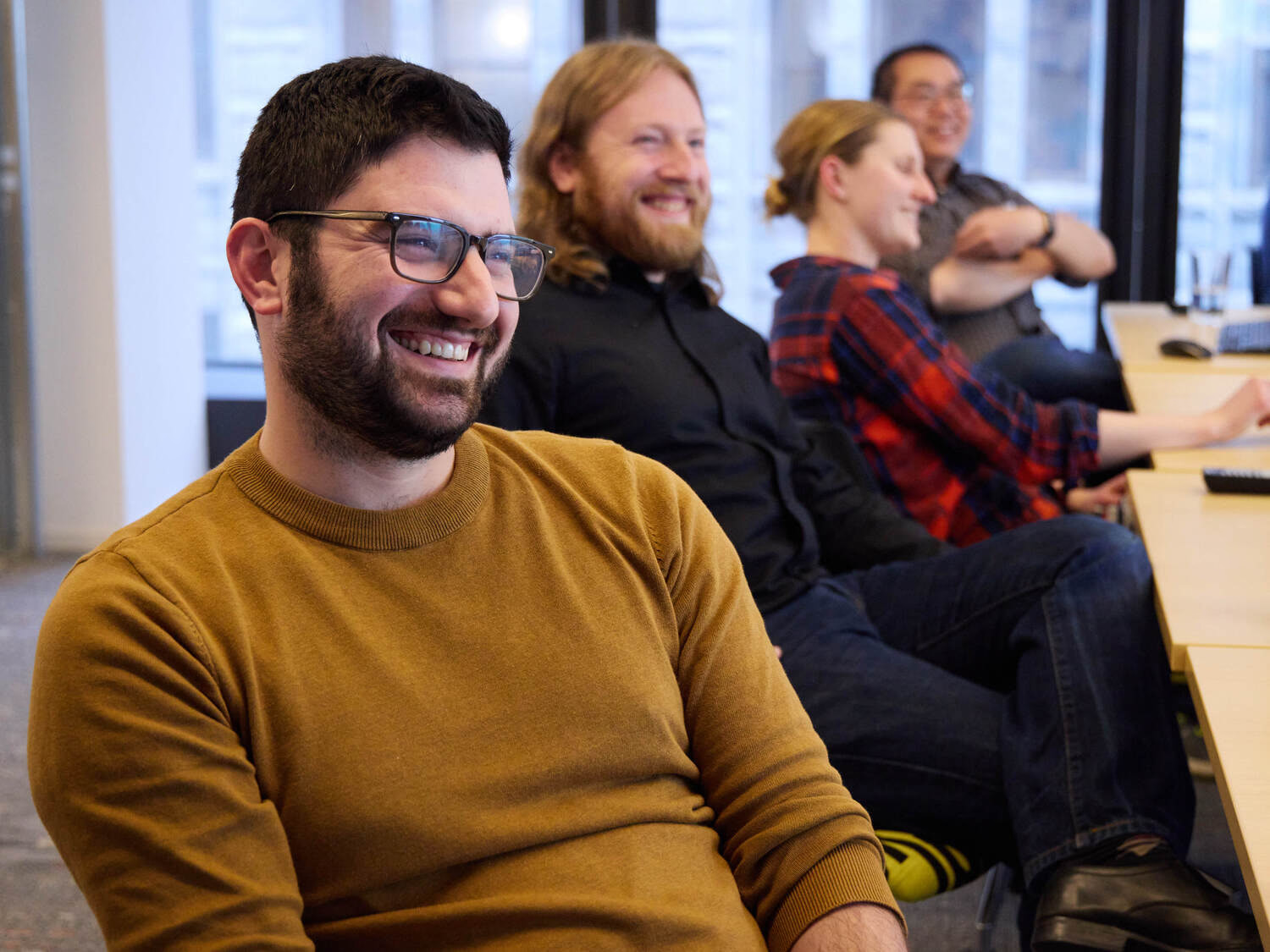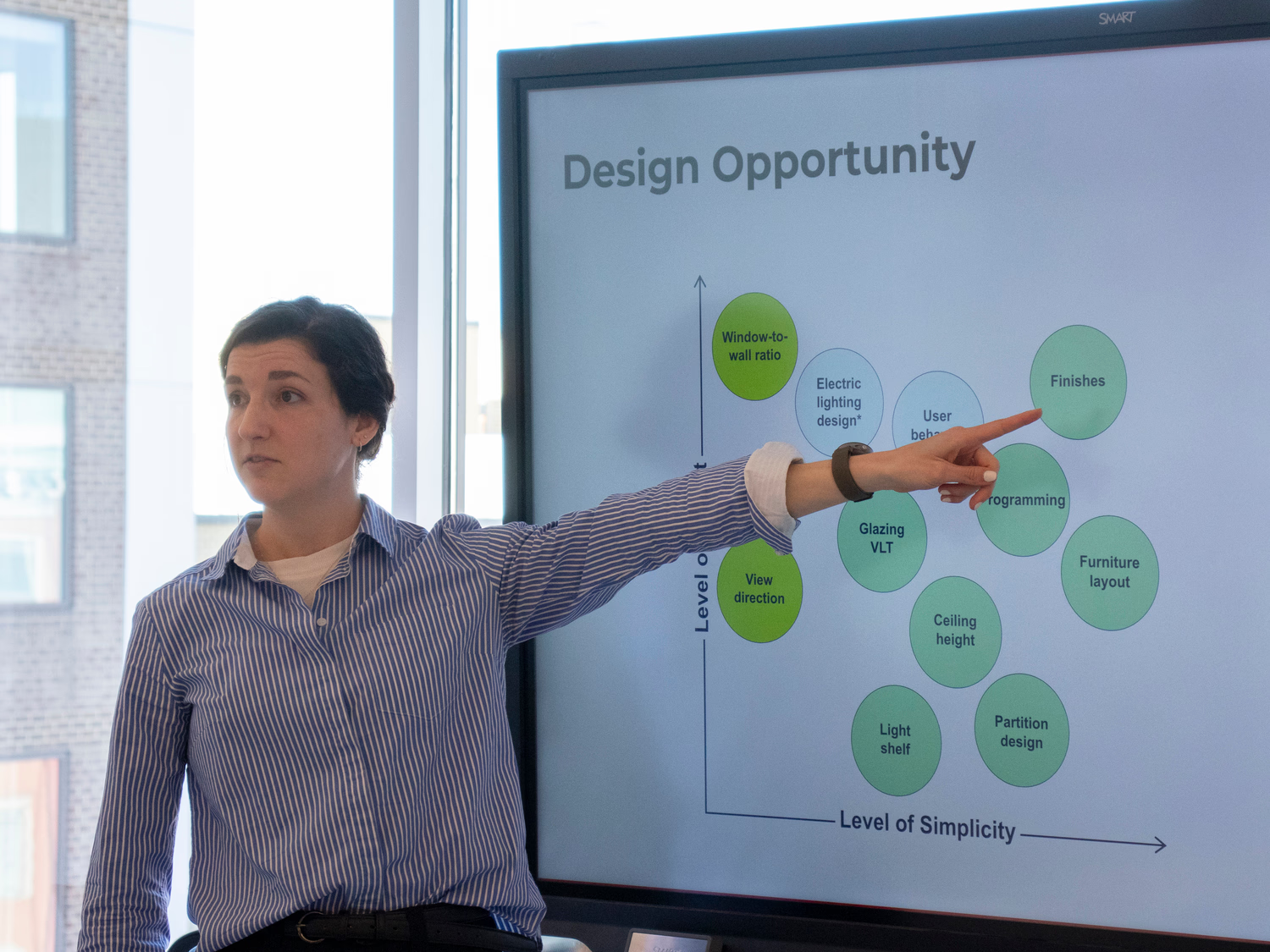.jpg)
Two of the team members from our Detroit office were recently interviewed on Detroit Public Radio (WDET)’s The Metro program. Senior associate Angela Wyrembelski, AIA, and designer Sara Timberlake, LEED Green Associate, were invited onto the program to discuss the AIA Architecture Firm Award and share their thoughts on Detroit’s rich architectural history.
This [award] really marks a shift in mindset that places matter, existing buildings matter, and architecture can make a big impact on an existing place by preserving what’s there.
ANGELA WYREMBELSKI, AIA
Host Tia Graham noted our many projects in Detroit, including the repurposing of the B. Siegel building, our restoration work at Belle Isle, and the soon-to-reopen LOVE Building. Sara explained the practice of adaptive reuse, wherein a building is modified to support a different function than the one it was built for.
There's a lot of value [in existing buildings], not only in terms of stewarding the resources that we have, but also stewarding the people-stories that live in those buildings as well.
SARA TIMBERLAKE, LEED GREEN ASSOCIATE
Angela and Sara also discussed the inherent sustainability of building reuse—how we avoid additional greenhouse gas emissions by retaining a building’s embodied carbon. Sara invoked Quinn Evans principal emeritus Carl Elefante’s catchphrase, “the greenest building is the one that’s already built”—our argument for building reuse in a nutshell.
Listen to the entire interview on WDET’s website here. A transcript of the interview follows.
---
TIA GRAHAM, HOST
You know Detroit is known for many things. But one thing that often is overlooked in the city is our architecture. And one architecture firm in the city has been working on that a lot: Quinn Evans, an architecture firm with offices in Ann Arbor and Detroit, has projects across the city here including work on the B. Siegel building on Livernois, Belle Isle, and the Love Building in Detroit. Recently, Quinn Evans was recognized by the American Institute of Architects with the Architecture Firm Award for 2024. The award recognizes a firm that has consistently produced notable works of architecture for at least 10 years. Here to talk about what the award means and what they're doing to preserve Detroit's architecture, we have two guests with us. Angela Wyrembelski is a senior associate at Quinn Evans. Angela, welcome to The Metro.
ANGELA WYREMBELSKI
Hi there.
TIA GRAHAM
Awesome. And we have Sara Timberlake. She is a designer at Quinn Evans. Sara, welcome to The Metro.
SARA TIMBERLAKE
Hi, I'm so happy to be here.
TIA GRAHAM
Awesome. So, Angela, we're all nerds, especially on the show. And we talk about architecture all the time. We walk around Midtown, we see things we're just like, Oh, look at that. Look how beautiful that is! So tell us why it means so much for y'all to win this Architecture Firm Award and why it's such a big deal.
ANGELA WYREMBELSKI
Yeah, absolutely. This award recognizes a firm that is committed to design excellence and the built environment and making a positive impact in our communities. And this marks the first year that they've recognized a firm that is rooted in historic preservation. This really marks a shift in mindset that places matter, existing buildings matter, and architecture can make big impact on an existing place by preserving what's there.
TIA GRAHAM
We were just talking about history just now, Detroit history. Now I hear you talk about the historical preservation and just making sure that we're keeping Detroit's history and its legacy alive as much as possible, especially with everything that's moving and changing. So, Sara, restoration and preservation are big aspects of what Quinn Evans does. There's a term that seems to come up a lot in the firm, and it's called adaptive reuse. What is adaptive reuse? And why does Quinn Evans focus on it so much?
SARA TIMBERLAKE
Yeah, so for those who don't know, adaptive use is, kind of what the title implies, using a building that is already existing or using something that's already existing. I like to see it as breathing a new life into an older building. And I think something that is unique about Quinn Evans is something that we always say in our firm—that the greenest building is the building that's already built. And we really try to encapsulate that in the projects that we do, and the way that we think about it. For some people it may be easier just to demolish a building and have a new building from scratch. But there's a lot of value, not only in terms of stewarding the resources that we have, but also stewarding the people-stories that live in those buildings as well. So being able to adapt, whether bringing the building back to what it was used for before, or bringing back a building and bringing a new kind of experience into that building, is something that we really love—those types of projects at Quinn Evans.
TIA GRAHAM
So, Angela, another important focus for your firm is creating green buildings—those with a low carbon footprint. How do you take older buildings and in adapt that make them into, you know, carbon neutral zones?
ANGELA WYREMBELSKI
Absolutely. There's so much of an existing building that is built into it already. It's called embodied carbon. It is the, all the energy that you have to take, extract out of the earth and how you travel or how the materials get to a building site. All of that takes energy. And by retaining a building, that embodied energy is saved and kept and not, you know, extracted out of the site.
TIA GRAHAM
You know, because as you're saying that, my mind is just like, I never thought about the energy that it takes to get the certain resources to the building to power it up. So my mind is just going crazy with those type of questions right now. But just thinking about the city of Detroit right now—Sarah, you grew up in the city of Chicago, which is also one of those urban spaces, you know, a lot of neighborhoods, a lot of, you know, families and communities, but you call Detroit home now. So I think about, number one, when people move to the city of Detroit, they stay here. You went to University of Michigan. So you came for school. And you stayed?
SARA TIMBERLAKE
I did.
TIA GRAHAM
What was it about Detroit, Michigan, this metro Detroit area that said, I have to stay here?
SARA TIMBERLAKE
Yeah, there's a couple of things. So as I mentioned, I came to Michigan for grad school. And while I was in grad school, all of my design studios and artistic studios, they were about the city of Detroit. So because of my education, I was learning a lot about the city. And I think I was just really drawn by the people and the resilience of the folks that have lived here. I feel there's a lot of similarities between Chicago and Detroit, and I think there's just something about the charm of the city that has kept me here. And, of course, I had many opportunities to go back to Chicago, but I feel like Detroit just grabbed me to the city as its own. And I haven't left since.
TIA GRAHAM
And you know, Angela, the same question to you. Are you originally from Michigan?
ANGELA WYREMBELSKI
I'm from the west side of Michigan. I grew up in Muskegon and have been here in Detroit for the past eight years.
TIA GRAHAM
And same thing with you, you were on the west side. I know a lot of people come over and they say, you know, I'm just gonna stay. So you came over to the west side for school as well, and you decided to stay.
ANGELA WYREMBELSKI
I did, I absolutely loved it here.
TIA GRAHAM
So alright, so Sarah, when we talk about, of course, being from Chicago, and then now you're in the city of Detroit, what are some similarities or differences you see with the architecture and especially with preserving those spaces?
SARA TIMBERLAKE
Yeah. And I might speak a little bit more about what makes some of the architecture unique in Detroit. And, of course, both cities like Chicago and Detroit, they have really impressive downtowns with a lot of great skyscrapers and architectural history, both older buildings and newer buildings, like the Hudson site that’s going up. And it's been really exciting seeing that detailing—any of classic buildings like the Guardian building—and so many other structures. And what is special about Detroit is not only the downtown buildings that have this beautiful history, but even the houses and like the residential on the intimate level also have really unique housing, even I bought a house that's in the back of the neighborhood, and I love all the details that were there from the pre-WWII housing and the ways that you see those different details across the different housing structures. So I really enjoy that in Detroit in that way—architecture is a little democratized because everyone has an opportunity to experience it.
TIA GRAHAM
I was walking through West Village not too long ago on Detroit's east side, and just admiring how unique the homes are, and how different they are based on just who designed it. And you know, they're just, they're not the same, not one home is the same in that particular area. So I just think about the uniqueness that we have here with the architecture that we get to walk around and see every day. But then on the flip side, I think about some of the things that we are seeing, we do see our buildings being torn down, and we will see something that goes up in a neighborhood or a community that that just does not fit, it does not fit the aesthetic, it does not fit what's happening in that neighborhood. So what are your thoughts when you see some of those things? We're gonna start with you, Angela, and we're gonna go to Sarah.
ANGELA WYREMBELSKI
Right. It's always unfortunate when we lose something that's part of a community. It's, it's sometimes hard to see that that loss happen, and how a community reacts and heals from that loss. But we've also seen some really amazing stories of, you know, saving things. So we've been fortunate enough to be working on the Michigan Central Station project the past six years. I've personally been on that project that whole time. And it's such an amazing transformation, and it's a real true testament of that kind of grassroots Detroit grit, roll up your sleeves and get into it—and that saved that building. And the collaboration between all the tradespeople and the contractors and the community have really made this happen. Ten years ago you would have never—people never would have fathomed that that building could have been saved. So.
TIA GRAHAM
Yeah, I know. I mean, I just walk, when you drive through that Corktown area and you see it you just, you're almost blown away at how much has been transformed there. Sara, I know the same thing with you. You've been looking at—you've been here for a while now. And the seeing that area transform, what have you thought about expressing in terms of restoration?
SARA TIMBERLAKE
Yeah, I think I echo a lot what Angela said, I think there is a part of me that is a little sad when there are some of those older buildings that weren't able to be saved. And sometimes, as you know, we're affirming we really care about what the people want and keeping those people-centric stories. And even sometimes part of what the people may want might be some of those buildings coming down for some new life. But I do believe that architecture has the ability to heal and to heal communities, in that same way that it can breathe new life into it. So just seeing the new life in the Corktown area; other projects that I've had a chance to work on, like with Allied Media Love Building, I love so much being able to go into that building and see wow, look at that. That means space I was able to work with, and also even with a client like that, being able to work on a project where they really cared about how people are experiencing this building for people who have different abilities and different points of access, maybe different roles in life, such as being a mother and needing a mothering room. Seeing those different opportunities for where there is new life that can come into the built environment. And I think those kind of stories are really what keep me going.
TIA GRAHAM
I love it so much. Angela Wyrembelski is a senior associate at Quinn Evans. Sara Timberlake is a designer at Quinn Evans. Thank you both so much for joining us on The Metro, coming on the show to talk about the award you just recently received, the American Institute of Architects' Architecture Firm Award for 2024 and all the great things that you hope to see coming out of the city of Detroit. Thank you both for joining us.

.avif)





